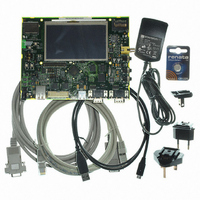AT91SAM9G45-EKES Atmel, AT91SAM9G45-EKES Datasheet - Page 990

AT91SAM9G45-EKES
Manufacturer Part Number
AT91SAM9G45-EKES
Description
KIT EVAL FOR AT91SAM9G45
Manufacturer
Atmel
Series
AT91SAM Smart ARMr
Type
MCUr
Datasheets
1.AT91SAM9G45-EKES.pdf
(56 pages)
2.AT91SAM9G45-EKES.pdf
(1218 pages)
3.AT91SAM9G45-EKES.pdf
(66 pages)
Specifications of AT91SAM9G45-EKES
Contents
Board
Processor To Be Evaluated
SAM9G45
Data Bus Width
32 bit
Interface Type
I2C, SPI, UART
Maximum Operating Temperature
+ 50 C
Minimum Operating Temperature
- 10 C
Operating Supply Voltage
1.8 V to 3.3 V
For Use With/related Products
AT91SAM9G45
Lead Free Status / RoHS Status
Lead free / RoHS Compliant
Other names
Q4626953
- Current page: 990 of 1218
- Download datasheet (19Mb)
6438F–ATARM–21-Jun-10
3. After the DMAC selected channel has been programmed, enable the channel by writing
4. Source and destination request single and chunk DMAC transactions to transfer the
5. When the buffer transfer has completed, the DMAC reloads the DMAC_SADDRx,
a. Write the starting source address in the DMAC_SADDRx register for channel x.
b. Write the starting destination address in the DMAC_DADDRx register for channel
c. Program DMAC_CTRLAx, DMAC_CTRLBx and DMAC_CFGx according to Row
d. Write the control information for the DMAC transfer in the DMAC_CTRLAx and
– i. Set up the transfer type (memory or non-memory peripheral for source and
– ii. Set up the transfer characteristics, such as:
e. If source picture-in-picture mode is enabled (DMAC_CTRLBx.SPIP is enabled),
f.
g. Write the channel configuration information into the DMAC_CFGx register for chan-
– i. Designate the handshaking interface type (hardware or software) for the source
– ii. If the hardware handshaking interface is activated for the source or destination
a ‘1’ to the DMAC_CHER.ENABLE[n] bit where is the channel number. Make sure that
bit 0 of the DMAC_EN register is enabled.
buffer of data (assuming non-memory peripherals). The DMAC acknowledges on com-
pletion of each chunk/single transaction and carry out the buffer transfer.
DMAC_DADDRx and DMAC_CTRLAx registers. Hardware sets the buffer Complete
interrupt. The DMAC then samples the row number as shown in
982. If the DMAC is in Row 1, then the DMAC transfer has completed. Hardware sets
the transfer complete interrupt and disables the channel. So you can either respond to
the Buffer Complete or Chained buffer transfer Complete interrupts, or poll for the
destination) and flow control device by programming the FC of the DMAC_CTRLBx
register.
and destination peripherals. This is not required for memory. This step requires
programming the SRC_H2SEL/DST_h2SEL bits, respectively. Writing a ‘1’ activates
the hardware handshaking interface to handle source/destination requests for the
specific channel. Writing a ‘0’ activates the software handshaking interface to handle
source/destination requests.
peripheral, assign handshaking interface to the source and destination peripheral.
This requires programming the SRC_PER and DST_PER bits, respectively.
– Transfer width for the source in the SRC_WIDTH field.
– Transfer width for the destination in the DST_WIDTH field.
– Source AHB master interface layer in the SIF field where source resides.
– Destination AHB master interface layer in the DIF field where destination resides.
– Incrementing/decrementing or fixed address for source in SRC_INCR field.
– Incrementing/decrementing or fixed address for destination in DST_INCR field.
x.
10 as shown in
‘0’.
DMAC_CTRLBx register for channel x. For example, in the register, you can pro-
gram the following:
program the DMAC_SPIPx register for channel x.
If destination picture-in-picture is enabled (DMAC_CTRLBx.DPIP), program the
DMAC_DPIPx register for channel x.
nel x. Ensure that the reload bits, DMAC_CFGx.SRC_REP,
DMAC_CFGx.DST_REP and DMAC_CTRLBx.AUTO are enabled.
Table 41-2 on page
982. Program the DMAC_DSCRx register with
AT91SAM9G45
Table 41-2 on page
990
Related parts for AT91SAM9G45-EKES
Image
Part Number
Description
Manufacturer
Datasheet
Request
R

Part Number:
Description:
MCU ARM9 64K SRAM 144-LFBGA
Manufacturer:
Atmel
Datasheet:

Part Number:
Description:
IC ARM7 MCU FLASH 256K 100LQFP
Manufacturer:
Atmel
Datasheet:

Part Number:
Description:
IC ARM9 MPU 217-LFBGA
Manufacturer:
Atmel
Datasheet:

Part Number:
Description:
MCU ARM9 ULTRA LOW PWR 217-LFBGA
Manufacturer:
Atmel
Datasheet:

Part Number:
Description:
MCU ARM9 324-TFBGA
Manufacturer:
Atmel
Datasheet:

Part Number:
Description:
IC MCU ARM9 SAMPLING 217CBGA
Manufacturer:
Atmel
Datasheet:

Part Number:
Description:
IC ARM9 MCU 217-LFBGA
Manufacturer:
Atmel
Datasheet:

Part Number:
Description:
IC ARM9 MCU 208-PQFP
Manufacturer:
Atmel
Datasheet:

Part Number:
Description:
MCU ARM 512K HS FLASH 100-LQFP
Manufacturer:
Atmel
Datasheet:

Part Number:
Description:
MCU ARM 512K HS FLASH 100-TFBGA
Manufacturer:
Atmel
Datasheet:

Part Number:
Description:
IC ARM9 MCU 200 MHZ 324-TFBGA
Manufacturer:
Atmel
Datasheet:

Part Number:
Description:
IC ARM MCU 16BIT 128K 256BGA
Manufacturer:
Atmel
Datasheet:

Part Number:
Description:
IC ARM7 MCU 32BIT 128K 64LQFP
Manufacturer:
Atmel
Datasheet:

Part Number:
Description:
IC ARM7 MCU FLASH 256K 128-LQFP
Manufacturer:
Atmel
Datasheet:

Part Number:
Description:
IC ARM7 MCU FLASH 512K 128-LQFP
Manufacturer:
Atmel
Datasheet:










